DPC
The 'Bit List' of Digitally Endangered Species
The DPC's 'Bit List' of Digitally Endangered Species is a crowd-sourcing exercise to discover which digital materials our community thinks are most at risk, as well as those which are relatively safe thanks to digital preservation. By compiling and maintaining this list over the coming years, the DPC aims to celebrate great digital preservation endeavors as entries become less of a ‘concern,’ whilst still highlighting the need for efforts to safeguard those still considered ‘critically endangered.’
A new edition of the Bit List will be published on World Digital Preservation Day, 7th November 2019.
-
LOWER RISK
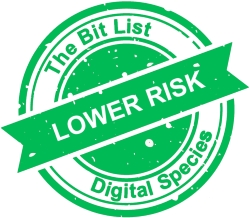
Digital materials are listed as Lower Risk when it does not meet the requirements for other categories but where there is a distinct preservation requirement. Failure or removal of the preservation function would result in re-classification to one of the threatened categories.
-
VULNERABLE
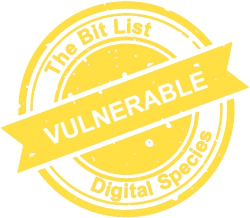
Digital materials are listed as Vulnerable when the technical challenges to preservation are modest but responsibility for care is poorly understood, or where the responsible agencies are not meeting preservation needs. This classification includes Lower Risk materials in the presence of aggravating conditions.
-
ENDANGERED
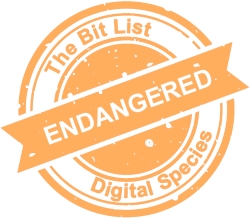
Digital materials are listed Endangered when they face material technical challenges to preservation or responsibility for care is poorly understood, or where the responsible agencies are poorly equipped to meet preservation needs. This classification includes Vulnerable materials in the presence of aggravating conditions.
-
CRITICALLY ENDANGERED
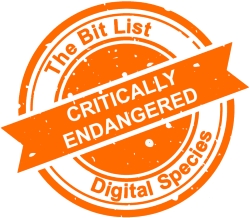
Digital materials are listed Critically Endangered when they face material technical challenges to preservation, there are no agencies responsible for them or those agencies are unwilling or unable to meet preservation needs. This classification includes Endangered materials in the presence of aggravating conditions.
-
PRACTICALLY EXTINCT
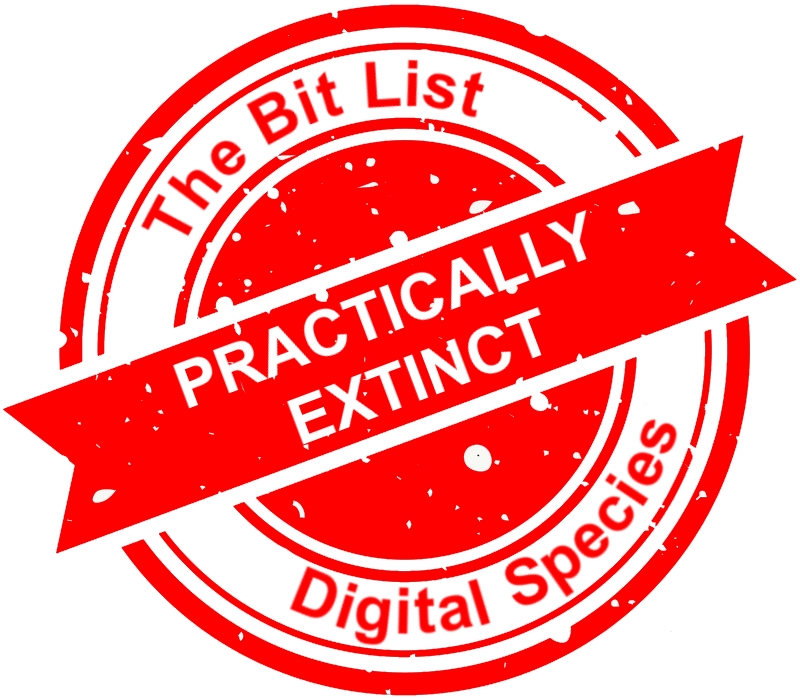
Digital materials are listed as Practically Extinct when the few known examples are inaccessible by most practical means and methods. This classification includes Critically Endangered materials in the presence of aggravating conditions.
-
CONCERN
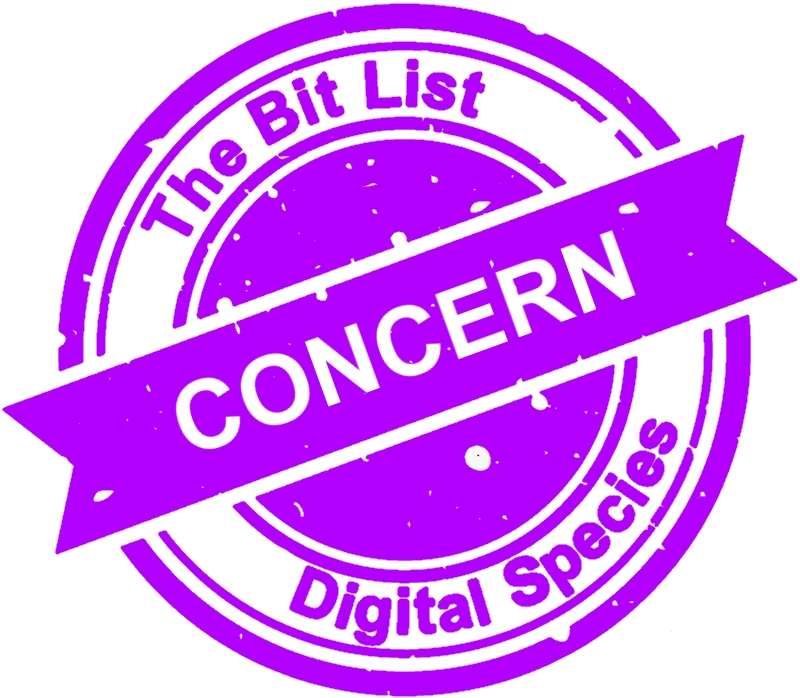
Digital materials are listed as of Concern when an active member of the digital preservation community has expressed a legitimate concern but the concern has not yet been assessed by the BitList jury. They will be assessed for inclusion in the subsequent year.
Listen to William Kilbride talking to the BBC Click programme about the Bit List
The 'Bit List' of Digitally Endangered Species
-
Nominate at-risk digital materials now!
The Bit List remains open for nominations year round
NOMINATE AT-RISK DIGITAL MATERIALS
If you are unable to access the Google form to nominate your at-risk digital materials or you would like to prepare your information in advance,
please download and complete the Excel version of the form.
Completed Excel forms may be sent to Sarah Middleton.
The DPC's 'Bit List' of Digitally Endangered Species is a crowd-sourcing exercise to discover which digital materials our community thinks are most at risk, as well as those which are relatively safe thanks to digital preservation. By compiling and maintaining this list over the coming years, the DPC aims to celebrate great digital preservation endeavors as entries become less of a ‘concern,’ whilst still highlighting the need for efforts to safeguard those still considered ‘critically endangered.’
- Access the full text the the Revised Bitlist List Report for 2020
- (see also the text of the BitList Report for 2019, now superceded)
Click on each of the risk classifications to see the entries for each category, browse the Bit List by digital species or click each entry for the full report:
Risk Classifications
-
LOWER RISK

Digital materials are listed as Lower Risk when it does not meet the requirements for other categories but where there is a distinct preservation requirement. Failure or removal of the preservation function would result in re-classification to one of the threatened categories.
There are no entries classified as Lower Risk in this edition of the BitList.
-
VULNERABLE

Digital materials are listed as Vulnerable when the technical challenges to preservation are modest but responsibility for care is poorly understood, or where the responsible agencies are not meeting preservation needs. This classification includes Lower Risk materials in the presence of aggravating conditions.
-
ENDANGERED

Digital materials are listed Endangered when they face material technical challenges to preservation or responsibility for care is poorly understood, or where the responsible agencies are poorly equipped to meet preservation needs. This classification includes Vulnerable materials in the presence of aggravating conditions.
3D Digital Engineering DrawingsBorn Digital Photographs and Video shared via Social Media or Uploaded to Cloud Services
Completed investigations based on open source intelligence sources
Consumer cloud-based utilities
Consumer social media free at the point of use
Contractual Documents and Related Records
Corporate Records of Long Duration on Network Drives,
Intranets and EDRMSCurrent Portable Magnetic Media
Current Portable Optical Media
Current Portable Solid-State Media
Digital materials in museums and galleries
Digitally published sheet music
Digital music and ephemera shared on social media
Electronic hospital and medical records
Massively Multiple Online Gaming Platforms and
ExperiencesMaster Digital Music and Sound Recordings
Premium or institutional social media services
Pre-Production TV and Movie Materials
Proceedings and Evidence in Court
Recordings of video game play uploaded to online platforms
Records of Quasi Non-Governmental Agencies
-
CRITICALLY
ENDANGERED
Digital materials are listed Critically Endangered when they face material technical challenges to preservation, there are no agencies responsible for them or those agencies are unwilling or unable to meet preservation needs. This classification includes Endangered materials in the presence of aggravating conditions.
Adobe Flash animations and interactive applets
Born Digital Images Held Offline on Portable Storage Devices
Community generated content in arts and heritage
Correspondence and records of research
Data posted to defunct or little-used social
media platformsDigital Archives from Public Enquiries and Commissions
Digital archives of community groups
Digital Archives of music production
Digital Evidence and records of investigation prior to court
Legacy research web collections
Maritime Archaeological Archives
Media Art by deceased artists or defunct workshops
Non-current Hard Disk Technologies
Non-current Portable Magnetic Media
Non-current Portable Optical Media
Non-current Portable Solid State Media
Old or non-current video games
Open source intelligence sources of current conflicts
Records of Non-Governmental Agencies
-
PRACTICALLY
EXTINCT
Digital materials are listed as Practically Extinct when the few known examples are inaccessible by most practical means and methods. This classification includes Critically Endangered materials in the presence of aggravating conditions.
-
CONCERN

Digital materials are listed as of Concern when an active member of the digital preservation community has expressed a legitimate concern but the concern has not yet been assessed by the BitList jury. They will be assessed for inclusion in the subsequent year.
There are no entries classified as Of Concern in this edition of the BitList.
Download the BitList 2019 Poster
Watch the Recording of the Introduction to the Bit List of Digitally Endangered Species
The 'Bit List' of Digitally Endangered Species
The Global List of Digitally Endangered Species – The Bit List – offers an accessible snapshot of the concerns expressed by the global digital preservation community with respect to the risks faced by diverse types of digital content in varied conditions and contexts. It provides an elementary assessment of the imminence and significance of the dangers faced by different, and at times overlapping classifications of digital materials. By identifying the urgency of action and significance of content, The Bit List draws attention to those digital materials that, in the view of the global digital preservation community, require urgent action to remain viable.
Access the full Bit List List Report for 2021
-
Watch the Introduction to the Bit List of Digitally Endangered Species 2021
Click on each of the risk classifications to see the entries for each category, browse the Bit List by digital species or click each entry for the full report:
Risk Classifications
-
LOWER RISK

Digital materials are listed as Lower Risk when it does not meet the requirements for other categories but where there is a distinct preservation requirement. Failure or removal of the preservation function would result in re-classification to one of the threatened categories.
There are no entries classified as Lower Risk in this edition of the BitList.
-
VULNERABLE

Digital materials are listed as Vulnerable when the technical challenges to preservation are modest but responsibility for care is poorly understood, or where the responsible agencies are not meeting preservation needs. This classification includes Lower Risk materials in the presence of aggravating conditions.
-
ENDANGERED

Digital materials are listed Endangered when they face material technical challenges to preservation or responsibility for care is poorly understood, or where the responsible agencies are poorly equipped to meet preservation needs. This classification includes Vulnerable materials in the presence of aggravating conditions.
3D Digital Engineering Drawings
Born Digital Photographs and Video shared via Social Media or Uploaded to Cloud Services
Cloud-based Services and Communications Platforms
Completed investigations based on open source intelligence sources
Content on cloud video services produced by the service provider
Contractual Documents and Related Records
Corporate Records of Long Duration on Network Drives,
Intranets and EDRMSCurrent Portable Magnetic Media
Current Portable Optical Media
Current Portable Solid-State Media
Digital music and ephemera shared on social media
Digital recordings published via cloud-based music sharing platforms
Digitally published sheet music
Electronic hospital and medical records
Master Digital Music and Sound Recordings
Pre-Production TV and Movie Materials
Published research data appended to journal articles
-
CRITICALLY
ENDANGERED
Digital materials are listed Critically Endangered when they face material technical challenges to preservation, there are no agencies responsible for them or those agencies are unwilling or unable to meet preservation needs. This classification includes Endangered materials in the presence of aggravating conditions.
Community generated content in arts and heritage
Consumer social media free at the point of use
Correspondence and records of research
Data posted to defunct or little-used social media platforms
Digital Archives from Public Enquiries and Commissions
Digital archives of community groups
Digital Archives of music production
Digital Evidence and records of investigation prior to court
Legacy research web collections
Massively Multiple Online Gaming Platforms and Experiences
Media Art by deceased artists or defunct workshops
Non-current Hard Disk Technologies
Non-current Portable Magnetic Media
Non-current Portable Optical Media
Non-current Portable Solid State Media
Old or non-current offline video games
Old or non-current video games
Open source intelligence sources of current conflicts
Pre-WWW ViewData and Teletext Services where no Archival Agency has Captured and Retained the Signal
Records of Non-Governmental Agencies
Records of Quasi Non-Governmental Agencies
Supporting Digital Materials for Museums and Galleries
-
PRACTICALLY
EXTINCT
Digital materials are listed as Practically Extinct when the few known examples are inaccessible by most practical means and methods. This classification includes Critically Endangered materials in the presence of aggravating conditions.
-
CONCERN

Digital materials are listed as of Concern when an active member of the digital preservation community has expressed a legitimate concern but the concern has not yet been assessed by the BitList jury. They will be assessed for inclusion in the subsequent year.
There are no entries classified as Of Concern in this edition of the BitList.
Digital Species
Species Categories
-
Nominate at-risk digital materials now!
The Bit List remains open for nominations year round
NOMINATE AT-RISK DIGITAL MATERIALS
If you are unable to access the Google form to nominate your at-risk digital materials or you would like to prepare your information in advance,
please download and complete the Excel version of the form.
Completed Excel forms may be sent to Sarah Middleton.
Access older versions of the Bit List, now superceded
The 'Bit List' of Digitally Endangered Species
The Global List of Digitally Endangered Species – The Bit List – offers an accessible snapshot of the concerns expressed by the global digital preservation community with respect to the risks faced by diverse types of digital content in varied conditions and contexts. It provides an elementary assessment of the imminence and significance of the dangers faced by different, and at times overlapping classifications of digital materials. By identifying the urgency of action and significance of content, The Bit List draws attention to those digital materials that, in the view of the global digital preservation community, require urgent action to remain viable.
READ THE 2022 BIT LIST OF DIGITALLY ENDANGERED SPECIES
Click on each of the risk classifications to see the entries for each category, browse the Bit List by digital species or click each entry for the full report:
Risk Classifications
-
LOWER RISK

Digital materials are listed as Lower Risk when it does not meet the requirements for other categories but where there is a distinct preservation requirement. Failure or removal of the preservation function would result in re-classification to one of the threatened categories.
There are no entries classified as Lower Risk in this edition of the BitList.
-
VULNERABLE

Digital materials are listed as Vulnerable when the technical challenges to preservation are modest but responsibility for care is poorly understood, or where the responsible agencies are not meeting preservation needs. This classification includes Lower Risk materials in the presence of aggravating conditions.
-
ENDANGERED

Digital materials are listed Endangered when they face material technical challenges to preservation or responsibility for care is poorly understood, or where the responsible agencies are poorly equipped to meet preservation needs. This classification includes Vulnerable materials in the presence of aggravating conditions.
3D Digital Engineering Drawings
Born Digital Photographs and Video shared via Social Media or Uploaded to Cloud Services
Cloud-based Services and Communications Platforms
Completed investigations based on open source intelligence sources
Content on cloud video services produced by the service provider
Contractual Documents and Related Records
Corporate Records of Long Duration on Network Drives,
Intranets and EDRMSCurrent Portable Magnetic Media
Current Portable Optical Media
Current Portable Solid-State Media
Digital music and ephemera shared on social media
Digital recordings published via cloud-based music sharing platforms
Digitally published sheet music
Electronic hospital and medical records
Master Digital Music and Sound Recordings
Pre-Production TV and Movie Materials
Published research data appended to journal articles
-
CRITICALLY
ENDANGERED
Digital materials are listed Critically Endangered when they face material technical challenges to preservation, there are no agencies responsible for them or those agencies are unwilling or unable to meet preservation needs. This classification includes Endangered materials in the presence of aggravating conditions.
Community generated content in arts and heritage
Consumer social media free at the point of use
Correspondence and records of research
Data posted to defunct or little-used social media platforms
Digital Archives from Public Enquiries and Commissions
Digital archives of community groups
Digital Archives of music production
Digital Evidence and records of investigation prior to court
Legacy research web collections
Massively Multiple Online Gaming Platforms and Experiences
Media Art by deceased artists or defunct workshops
Non-current Hard Disk Technologies
Non-current Portable Magnetic Media
Non-current Portable Optical Media
Non-current Portable Solid State Media
Old or non-current offline video games
Old or non-current video games
Open source intelligence sources of current conflicts
Pre-WWW ViewData and Teletext Services where no Archival Agency has Captured and Retained the Signal
Records of Non-Governmental Agencies
Records of Quasi Non-Governmental Agencies
Supporting Digital Materials for Museums and Galleries
-
PRACTICALLY
EXTINCT
Digital materials are listed as Practically Extinct when the few known examples are inaccessible by most practical means and methods. This classification includes Critically Endangered materials in the presence of aggravating conditions.
-
CONCERN

Digital materials are listed as of Concern when an active member of the digital preservation community has expressed a legitimate concern but the concern has not yet been assessed by the BitList jury. They will be assessed for inclusion in the subsequent year.
There are no entries classified as Of Concern in this edition of the BitList.
Digital Species
Species Categories
-
Nominate at-risk digital materials now!
The Bit List remains open for nominations year round
NOMINATE AT-RISK DIGITAL MATERIALS
If you are unable to access the Google form to nominate your at-risk digital materials or you would like to prepare your information in advance,
please download and complete the Excel version of the form.
Completed Excel forms may be sent to Sarah Middleton.
Access older versions of and introductions to the Bit List, now superceded:
-
Introduction to the Bit List of Digitally Endangered Species 2021
The Global 'Bit List' of Endangered Digital Species
What is the Bit List?
A free-to-access and open resource for digital preservation advocacy, the DPC's Global Bit List of Endangered Digital Species (or Bit List for short) is a community-sourced list of at-risk digital materials which is revised every two years. Entries to the list are nominated by the community, who are at the forefront of digital preservation efforts, and reviewed by international organizations which represent global expertise in the preservation of the listed digital species.
By compiling and maintaining the Bit List, the DPC aims to equip digital preservation practitioners with independent evidence that digital materials are critically endangered, and that action is required, in order to support their targeted advocacy efforts.
Risk Classifications
Current entries were last nominated to the Bit List in 2023. Entries are grouped by risk ‘classification’ and digital ‘species.’ Click on each of the risk classifications to see the entries for each category, browse the Bit List by digital species and click each entry for the full report.
-
PRACTICALLY
EXTINCT
Digital materials are listed as Practically Extinct when the few known examples are inaccessible by most practical means and methods. This classification includes Critically Endangered materials in the presence of aggravating conditions.
-
CRITICALLY
ENDANGERED
Digital materials are listed Critically Endangered when they face material technical challenges to preservation, there are no agencies responsible for them or those agencies are unwilling or unable to meet preservation needs. This classification includes Endangered materials in the presence of aggravating conditions.
Community generated content in arts and heritage
Consumer social media free at the point of use
Correspondence and records of research
Data posted to defunct or little-used social media platforms
Digital archives of community groups
Digital Archives of music production
Digital Archives from Public Enquiries and Commissions
Digital Evidence and records of investigation prior to court
Games with Offline Play Components
Games with Online Play Components
Legacy research web collections
Manuals, Documentation, and Associated Materials
Media Art by deceased artists or defunct workshops
Non-current Hard Disk Technologies
Non-current Portable Magnetic Media
Non-current Portable Optical Media
Non-current Portable Solid State Media
Open source intelligence sources of current conflicts
Pre-WWW ViewData and Teletext Services where no Archival Agency has Captured and Retained the Signal
Records of Non-Governmental Agencies
Records of Quasi Non-Governmental Agencies
-
ENDANGERED

Digital materials are listed Endangered when they face material technical challenges to preservation or responsibility for care is poorly understood, or where the responsible agencies are poorly equipped to meet preservation needs. This classification includes Vulnerable materials in the presence of aggravating conditions.
3D Digital Engineering Drawings
Born Digital Photographs and Video shared via Social Media or Uploaded to Cloud Services
Cloud-based Services and Communications Platforms
Collections Information Management Data and Systems
Completed investigations based on open source intelligence sources
Content on cloud video services produced by the service provider
Contractual Documents and Related Records
Corporate Records of Long Duration on Network Drives, Intranets and EDRMS
Current Portable Magnetic Media
Current Portable Optical Media
Current Portable Solid-State Media
Digital music and ephemera shared on social media
Digital recordings published via cloud-based music sharing platforms
Digitally published sheet music
Electronic hospital and medical records
First Nations Secret/Sacred Cultural Material
Original Digital Music and Sound Recordings
Pre-Production TV and Movie Materials
Recordings of video game play uploaded to online platforms
-
VULNERABLE

Digital materials are listed as Vulnerable when the technical challenges to preservation are modest but responsibility for care is poorly understood, or where the responsible agencies are not meeting preservation needs. This classification includes Lower Risk materials in the presence of aggravating conditions.
-
LOWER RISK

Digital materials are listed as Lower Risk when it does not meet the requirements for other categories but where there is a distinct preservation requirement. Failure or removal of the preservation function would result in re-classification to one of the threatened categories.
There are no entries classified as Lower Risk in this edition of the BitList.
-
CONCERN

Digital materials are listed as of Concern when an active member of the digital preservation community has expressed a legitimate concern but the concern has not yet been assessed by the BitList jury. They will be assessed for inclusion in the subsequent year.
There are no entries classified as Of Concern in this edition of the BitList.
Digital Species
Species Categories
-
Nominate at-risk digital materials now!
The Global Bit List of Endangered Digital Species is open for nominations of at-risk material from the digital preservation community all year round.
Submit a nomination now for consideration as part of the next review cycle for the Bit List 2025.
NOMINATE AT-RISK DIGITAL MATERIALS
If you are unable to access the Google form to nominate your at-risk digital materials or you would like to prepare your information in advance,
please download and complete the Excel version of the form.
Completed Excel forms may be sent to This email address is being protected from spambots. You need JavaScript enabled to view it..
Access previous versions of and introductions to the Bit List, now superceded:
-
Introduction to the Bit List of Digitally Endangered Species 2021
Edinburgh Preserves: The Third Batch!
One of the really nice things about working in digital preservation is the community’s friendly, open attitude. Practitioners regularly come together in formal and informal contexts – both invaluable – to share ideas, reflect on challenges, and learn from one another. It’s a testament to our collective benevolence that these gettogethers, often attended by colleagues from highly varied backgrounds and organisations, are consistently provide confidence and inspiration in what we do.
Such exchanges can work locally, too, and Edinburgh Preserves is one example of this; a local group that brings together a merry band of practitioners from across the greater Edinburgh area (and beyond!) who work in digital preservation, for informal discussion and networking.
The Data Vanishes
It’s time to come clean: I no longer know what data is. I am looking pretty hard but I just can’t see it any more. It’s a troubling realisation for someone who has spent twenty years or so trying to preserve the stuff. But the most unsettling part is this: I don’t think it’s me who is lost. Don’t get me wrong, this is not some delayed attack of post-modern angst. I am just trying to get to the end of the day. Is it possible that, just as it was reaching a crescendo of profile, polemic and promise, data has vanished, like Bilbo Baggins on his eleventy-first birthday?
Art Conservation Meet Software Engineering: Converging Practices in the Preservation of Software-based Art
At a conference earlier this year, the topic of preserving artworks involving digital media had been a recurring topic of discussion during and after talks. One artist, who works extensively with software as a medium, was clearly a little baffled by this preoccupation. Having a background in software engineering, they were quick to point out that this domain has been dealing with these kinds of problem for decades! An interesting provocation - but how much truth is there to it? Can software engineering principles really help solve of our digital preservation woes? In this blog post I will consider what we might learn from the discipline and how such a meeting of practices might be navigated.
Lancaster University Library Joins the DPC
Added on 17 August 2017
The Digital Preservation Coalition welcomes Lancaster University Library as its newest Associate Member this week.
Currently establishing its digital preservation policy specifically to look after the long-term preservation of research outcomes, the Library’s key aim is to ensure that future generations can benefit from the scholarly digital outputs created by the world-class research and teaching undertaken at Lancaster University. One of the Jisc RDSS pilot institutions, Lancaster University brings extensive experience of working with shared services, interoperability between systems and applying this expertise to digital preservation.
Back to the Cave: Communicating the Importance of Web Archiving to Everybody Who Doesn’t Already Care about Web Archiving

It’s entirely wrong, and it’s the road back to the cave. The way we got out of the caves and into modern civilisation is through the process of understanding and thinking. Those things were not done by gut instinct. -Professor Brian Cox
Chapter 1: Fluent in Eyebrow
In keeping with the last few blog posts by William Kilbride and Sarah Higgins, I am going to share my version of the proverbial experience of explaining information profession jobs to outsiders. In my case, a mildly awkward social interaction slightly intensified by my immigration status. For a year or so I waffled on how to describe my work to UK Border Control without arousing suspicion. Was that quizzical eyebrow code for: What kind of criminal can’t even explain her own job in fewer than 20 words?

























































































































































